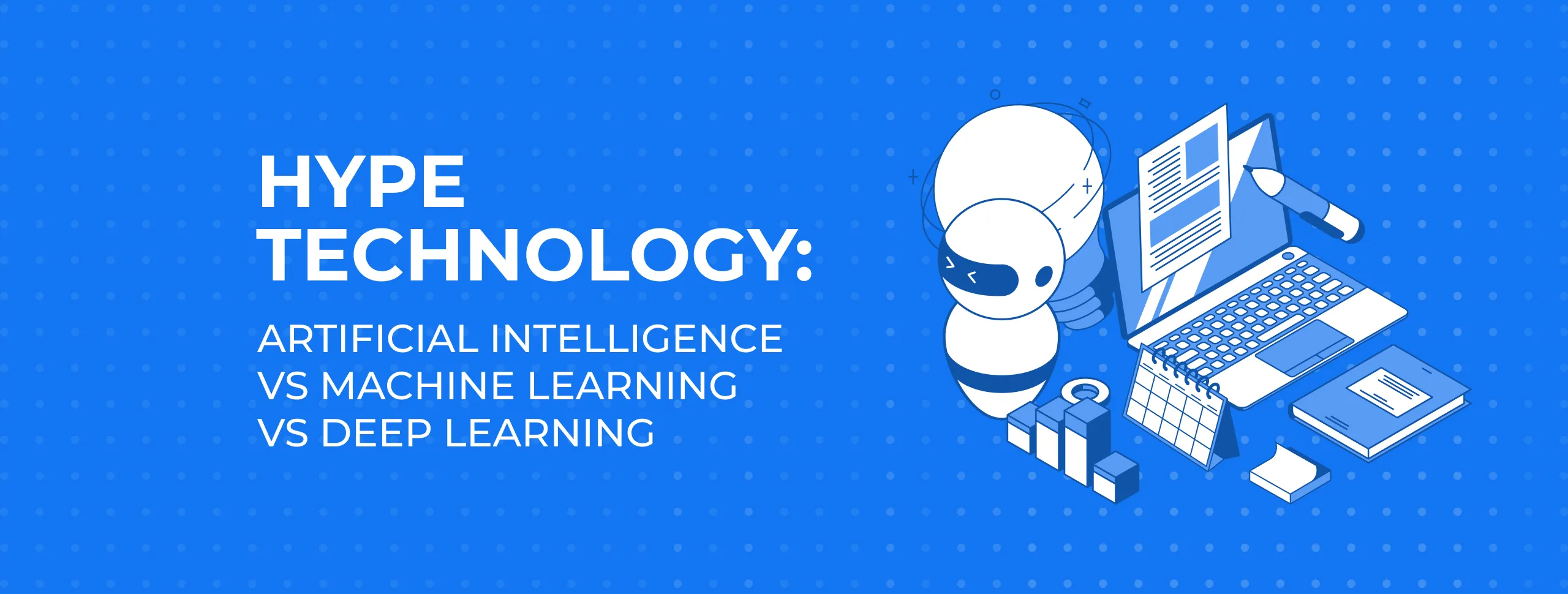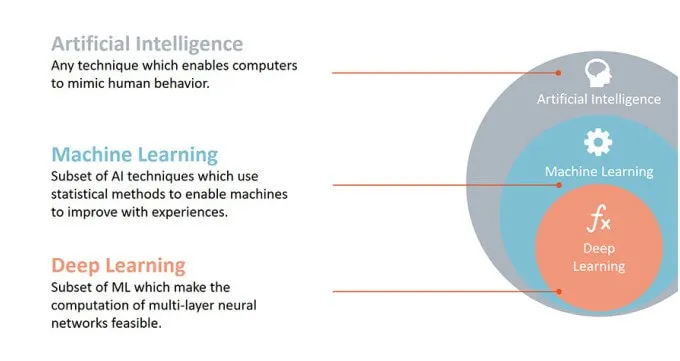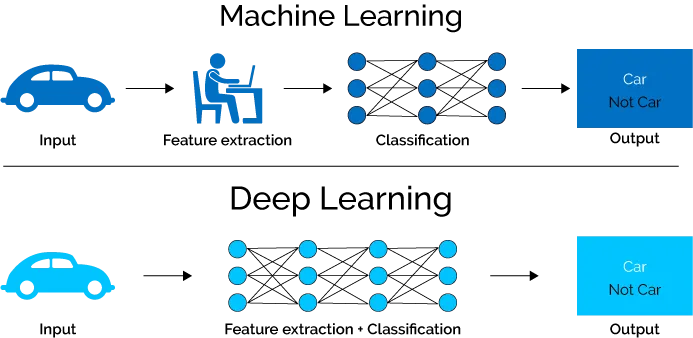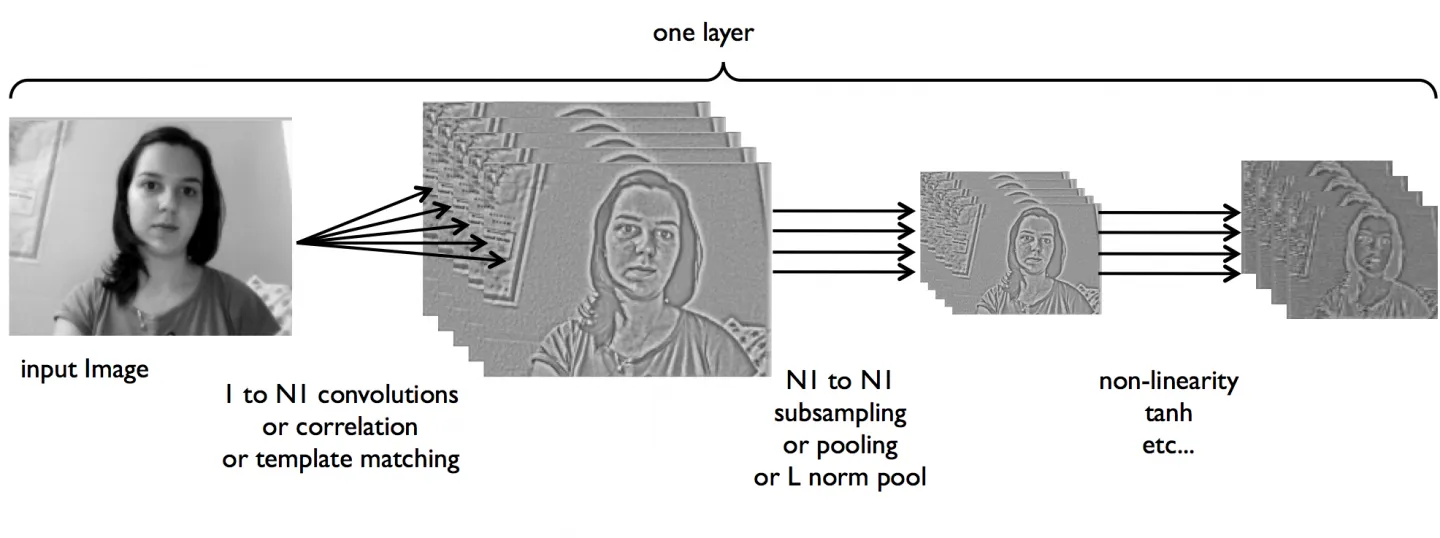
Hype technology: artificial intelligence vs machine learning vs deep learning

Artificial intelligence, Machine Learning and Deep Learning are terms you might hear often, but can you really tell the difference between the three? Let’s find out.
Artificial Intelligence
A bit of history
The term Artificial Intelligence first appeared in 1956 during a Dartmouth conference to introduce computer methods that would be able to demonstrate reason and creativity in solving tasks with greater efficiency and productivity than humans.

Evolution of the term
When we’re talking about the AI of today, we shouldn’t interpret “intelligence” in the same way as “intellect”.
- Creating human-like machines is a fairly interesting concept from a scientific point of view but isn’t what industries demand.
- We don’t need emotional robots like in the film “Bicentennial Man”. What we do need is to provide lightning-fast customer support, analyse financial trends with advanced accuracy and increase safety by checking in visitors using a system that cannot be fooled or bribed. And this can be achieved by applying advanced mathematical algorithms.
So, AI is a scientific field that is trying to model the most significant intellectual functions of the human brain: natural language processing, autonomous learning and creativity.
However, within the scope of this term, we can also refer to
- IT area of expertise. The goal is to create intelligent systems that can make reasonable decisions and take independent actions in order to solve tasks, thus liberating staff from routine jobs, optimising business processes and so on;
- it can be also understood as the general ability of an artificially modified system to interpret the environment or data input, learn from it and use this knowledge to achieve certain goals.
AI specialists are mainly going in two directions:
- solving problems connected with the development and implementation of AI systems in order to bring them further in line with human capabilities;
- creating software that connects all the latest achievements into one system effective at satisfying the needs of the market.

In order to create an Artificial Intelligence solution, we need to apply one or several of the following methods:
- Machine Reasoning – this encompasses the processes of planning, data representation, searching and optimisation for AI systems;
- Robotics – this is the field of science that concerns building, developing and controlling robots, including hardware issues (sensors, trackers and drives) and integration of all the components into the cyber systems’ architecture;
- Machine Learning is the study of algorithms and computer models as used by machines in order to perform a given task. Some examples are Classical Learning, Neural networks and Reinforcement Learning.
All in all, artificial intelligence includes machine learning as one of the methods of its practical implementation. Within machine learning, there are many different algorithms such as T-distributed scholastic neighbour embedding, Leabra and Neural networks (NN). In turn, Deep learning is just one of the implementation methods for NN algorithms, also known as deep neural learning or deep neural network.
A bit more about Machine Learning and Deep Learning

You can call Machine Learning a class or a group of methods that has the goal of teaching a computer to solve a task during the process of cracking similar tasks and finding patterns. There are different ways to classify these methods.
This is the system we have chosen:
- supervised, where a human guides the computer and corrects its mistakes;
- unsupervised, where the machine learns to find patterns by itself;
- reinforcement - through a system of treats and punishments the computer learns to take the optimum actions in a certain environment.
Now let’s have a more detailed look at how exactly the process of Machine learning happens.
How does the computer learn?
Data Science

Data Science lies at the heart of AI technology. What do data scientists do and how is it connected with Machine Learning?
For the computer to learn it is necessary to have these three components:
- A dataset – a collection of values that relate to a particular area. For instance, a class register is a database of grades of a certain group of students in many different subjects;
- features – a trait that represents measurable pieces of data that can be used for analysis. Following our example, it can take the form of columns such as “Name”, “Subject” or “Grade”;
- algorithm – computer methods of solving a certain task. For example, you can write an algorithm that calculates the average score in each subject.
Data scientists are the people who collect, filter and classify data in order to provide the computer with clear material by which to learn. Errors and lacunes in databases lead to incorrect results. So, without the work of data scientists, even the most sophisticated AI algorithms are useless.
Computer learning

To make ML work you need a huge collection of data – this can comprise images, videos, text or even situations. You want to teach the computer to perform a certain action – for example, find photos that contain kitties – and put them into a special folder.
For each image that you show the computer in this case, one response would be given – it’s either a kitty or not a kitty. This dependency between the object (the image) and response (kitty or not kitty) is called a training set.

- If you choose to work with Deep Learning, you simply download 100 thousand images of kitties to the processor and wait until it finds the patterns – four legs, two ears, a tail and so on. The machine needs to retrieve the hidden patterns in order to build an algorithm that is able to provide a classification precise enough to apply to every possible input object.
- An induction method like Reinforcement Learning implies that you allow the computer to learn by itself through trial and error. The computer gets a reward every time it does something right. For example, in the case of a driverless car, not hitting the passenger will earn it +500 points. If it makes mistakes the human will deduct the points – very similar to the way in which children learn.
- In classical machine learning, you can either sit and highlight the traits typical for cats yourself, or you can use unsupervised methods like classification and clustering. In order to estimate the precision of the responses you get, you need to invent functional quality criteria.
In real life, the tasks can be very different. For example, the data concerning the objects can be incomplete, imprecise, non-quantitative and heterogeneous. Various methods cope with certain tasks better than with others, which is why there are so many different methods.
As for the results, machines sometimes do achieve impressive results in diagnosis and business intelligence, though they’re still very far from being able to learn without human help.
More details about deep learning are available via this link.
Popular machine learning algorithms

We have already talked about Deep Learning and Reinforcement Learning, but there are other popular algorithms that we use every day. For example:
- Naive Bayes classifier – used for spam filtration, fraud detection and sentiment analysis.
- Regression – often applied to forecast stock fluctuations and medical diagnosis.
- Clustering – used to analyse and label data for market segmentation and consumer behaviour.
- Generalisation – recommendation systems, risk management.
- Neural Networks – better than any other system for face recognition, but copes well with practically any task.
Today it’s believed that training computers to think like humans is more likely to be achieved through the use of neural networks. This model is the closest to the organisation of the neural system of the human brain and is able to provide heuristic empirical results. It’s good at recognising patterns, categorising and classifying information and labelling items, which makes it suitable for solving practically any task.
Here are some other articles about artificial intelligence, machine learning and deep learning that can help you to dive deeper into the subject:
- https://magora-systems.com/big-data-analytics-in-real-time/
- https://magora-systems.com/modern-trends-in-telemedicine/
- https://magora-systems.com/types-of-data-analytics/
- https://magora-systems.com/ai-to-boost-your-business/
- https://magora-systems.com/term-artificial-intelligence/
- https://magora-systems.com/smartphone-artificial-intelligence/
- https://magora-systems.com/what-neural-networks-can-do/
- https://magora-systems.com/machine-learning/
- https://magora-systems.com/10-software-development-trends-to-become-market-leader-2019/





